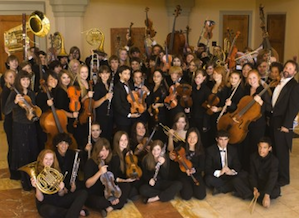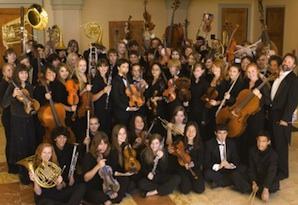
This is what she will always remember about playing in San Francisco’s Davies Symphony Hall. She was 13. It was 2009, the first year of the Bay Area Youth Orchestra Festival. She was with the Young People’s Symphony Orchestra (YPSO) in Berkeley. The piece was Hindemith’s Symphonic Metamorphosis, a difficult piece for a violinist, and she was particularly concerned about a portion of 16th-note runs in the middle of the second movement.
Still, practice made perfect, and at the end of the piece the orchestra finished together on what seemed like the same breath, and then came that moment — that subtle moment when the last note rings through the hall, followed by silence, which seems deafening because the sound in Davies Hall is so full, yet precise. She had never been in a place where you could hear yourself playing, no matter where you’re sitting, knowing you can’t hide; such an interesting sensation, especially compared to the Greek Orthodox Church in Oakland, where the orchestra had played, and a nice enough place but there that sound is like a night sky without the stars. In Davies Hall you hear each musician, and if it’s right, the final note rings through the hall, and then that silence, and the longer it lasts the more you know the audience is taking it in, they’ve heard you as you would like to be heard, followed by waves of applause. …
Beverly Fu will always remember that moment of silence.
Now, four years later, she has come completely into her own. She recently won YPSO’s 2013 concerto competition and will play a movement of Khachaturian’s Violin Concerto in May with the full orchestra of YPSO. But just now she’s been named concertmistress for the all-star festival orchestra in the fourth annual Bay Area Youth Orchestra festival.
The festival, hosted this year by the Santa Rosa Symphony Youth Orchestra, features nearly 400 musicians — ages 12 to 21 — will be held at the new Green Center’s Weill Hall on the campus of Sonoma State University, on Sunday, Jan. 20. Orchestras are coming from San Francisco, Marin, Oakland, Berkeley, and the host city, Sonoma. Benefits go to organizations that help homeless youth, which is part of what makes the festival unique.
“I came up with the idea following a conversation with a donor,” the festival’s founder, Wendy Cilman, said recently. “We felt it was important for kids to know that they could use their talent to benefit the homeless. That’s really core. A lot of our kids are themselves on scholarship, but through their love of playing they are able to benefit kids in an even worse situation.”
Beyond learning the ways and means of philanthropy, the festival is also an important source of socialization. “It’s not simply an artistic occasion,” says Jason Pyszkowski, manager of the San Francisco Symphony Youth Orchestra. “It’s also a chance to interact, to go out in the hall and socialize, to hear how others perform, to compare your level of performance. This is a very, very important part of the festival.”
The festival provides “a chance to interact, to go out in the hall and socialize, to hear how others perform, to compare your level of performance.” – Jason Pyszkowski
Gail Edwards, manager of the Oakland Youth Orchestra, adds that this is a once-in-a-teenager’s-lifetime chance “to be in a situation where they can feel completely comfortable and appreciated for their talent.”
The festival is open to all Bay Area youth orchestras, of which there are perhaps 12 to15. Preference for the next year goes to orchestras from the previous year. If one of those drops out, then it’s first come, first served. This year, a couple of orchestras from the past declined to perform.
But while there is a voluntary sense of rotation, along with the pressure of fulfilling other commitments, the festival remains a bit of a closed shop. As one administrator put it, “The problem is Davies Hall.” Everyone wants to play there, and if the competition were more open or if rotation were made mandatory, one wonders how that would affect the festival. As it stands, the San Francisco Symphony has agreed to host the festival every other year, to be the sole presenter and facilitator, and so, for example, how could the San Francisco Symphony Youth Orchestra ever be excluded? One idea has been to hold a two-day festival, but the logistics are just so difficult, schedules so full, accommodations so problematic, that that seems unlikely anytime soon.
The festival includes a performance by an “all-star” festival orchestra of about 130 musicians, arguably the most accomplished, chosen from each of the five participating orchestras.
“It’s like an NFL draft,” says Richard Loheyde, conductor of both the Santa Rosa Symphony Youth Orchesta and the festival orchestra. “Each conductor responds to a call for 25 musicians, and then we put together an orchestra. I would say it’s more in the spirit of collaboration, not necessarily who’s the best player. But still it becomes a little bit of a competition to get in; there’s more at stake; you’re playing on the edge of your chair.”
“I really wanted to be a musician and conductor, and I think a lot of that had to do with playing Mahler 2 in Symphony Hall in Boston.” – Richard Loheyde
Loheyde has chosen a Mahler symphony for the festival orchestra. “This is such a huge piece; youth orchestras don’t usually get to play it because of the length and the huge instrumentation. It’s also technically very demanding; this isn’t just black dots on the page. Not to mention a composer dealing with life and death in his family. But it is so great for kids, because it’s got everything, it’s the whole world in one movement, all the inner torments, and then that bombastic music that ends it.”
Loheyde had a similar experience as a violinist in the Greater Boston youth orchestra. “I really wanted to be a musician and conductor, and I think a lot of that had to do with playing Mahler 2 in Symphony Hall in Boston,” he relates. At 16, he went with the youth orchestra to Japan and played Mahler’s First. “That was a pivotal moment in my life, and from that I realized that this is something I really want to do in my life.”
Despite her success, and the sound of it in that moment of silence in Davies Hall, Beverly Fu will decline a career in music. Maybe she’ll go for a minor, but nothing more. If she gets her dream, she’ll go to MIT and major in one of the sciences.
“I see [music] as an escape from the world. … With music you need to be exceptional, and you need to make it your only priority.” – Concertmistress Beverly Fu
“I don’t think I ever considered a music major,” she says, “because I never thought I’d be able to concentrate long enough — you know, practicing every day for hours and hours. I’m more interested in exploring the world through a microscope. Music is a different kind of exploration. I see it as an escape from the world, which is why I really look forward to orchestra every week. It’s a great way to relieve stress. It’s a private world where I can hum along and enjoy playing with others. It’s really like a second family to me. … But with music you need to be exceptional, and you need to make it your only priority. I have a love for music but I don’t think I have as great a passion as my peers do.”
SFCV will have a presence at BAYOF Hope Festival. Stay posted for more.

